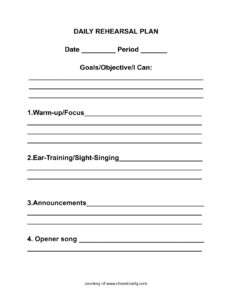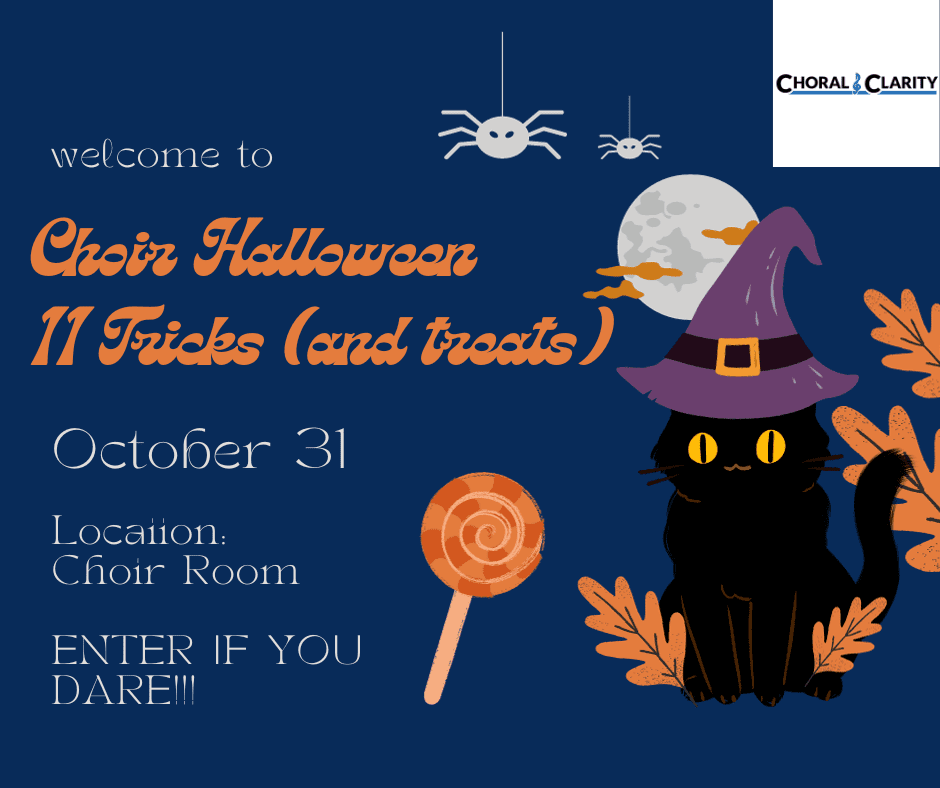A rehearsal observation can be really stressful, even for seasoned teachers.
When an authority figure is watching us, it can easily affect the way we deliver our intended lesson. On top of that, some of us tend to try too be overly ambitious or creative.
I want to help you to NAIL your OBSERVATION each and every time.
The most important thing regarding an observation is understanding your observer’s viewpoint.
What is your observer actually looking for?
The first thing you must remember is that they are not looking at you. Well, yes, they are looking at you, but all you really are is a facilitator.
You are facilitating the observation
Your class is being observed. You are in charge of what goes on in your class. As a result, you become the facilitator of student learning.
You are a facilitator of student learning. Student learning involves ensuring:
- students are paying attention
- students are engaged
- students are happy
Notice how I didn’t mention anything about singing. Well, that’s because its more than likely that your observer is not knowledgeable in vocal pedagogy or choral literature. They are, however, aware of how your students are responding to you, their level of engagement, and their overall demeanor.
Even if your administrator is knowledgeable in choir, they likely will be scheduled to observe fields of study that are not within their wheelhouse; my point is that administrators observe a big picture scope of what happens in the classroom, not a content-driven lens.
So let’s breakdown the things that will help you to nail your choir rehearsal observation:
1. There is a goal written on the board
While we know we are teaching them vocal technique, music literacy, and repertoire for the concert, a non-music administrator may not know this. I suggest putting some sort of big picture goal on the board. A big picture goal will allow for flexibility in your lesson. Here’s an example of big picture goals:
Today’s Goals:
- to continue to work on developing healthy vocal technique
- to continue to develop our music literacy
- to apply our developing vocal technique and music literacy to our choral repertoire as we prepare for the upcoming concert
Yes, it’s generic for us but it provides a clear understanding for an outside observer. With these goals, a typical choir rehearsal lesson plan will make sense.
Save 10% on Sight Reading Factory using checkout code: choralclarity
2. Start class on time
It doesn’t matter if there is only 1 student there: start on time. A warm-up allows students to quietly enter the room and join in.
ULTIMATE CONCERT ASSESSMENT BUNDLE – empower your singers and improve your concert!
3. Invite all students to participate
During the warm-up, some students may take time to unpack, briefly engage with friends, or focus. Give them a moment to unwind but then address the late-coming participants without stopping the rehearsal. “I’d like all eyes up here, please,” or “Let’s start focusing on warming up our voice now!”
It helps to make eye contact with students who are disengaged. You could even mention them by name, if needed.
This awareness of your room will show an observer right off the bat that you care about every student’s involvement.
Flat.io – save 15% on the best online music notation program
4. Keep all students engaged as much as possible
Warm-ups, ear-training and sight-singing can easily involve all of the singers all of the time. The more active ALL students are, the more successful your lesson will be.
If you choose to engage one section, be sure to give specific directions to the other sections.
While your attention is given to the “active” students, remember the observer will be equally drawing attention to the non-participating students.
Should you choose to focus on just one section, I suggest you have a predetermined plan for sections that are not singing.
Here is an example:
“Altos, can you demonstrate this phrase. Everyone else, listen to the alto’s phrase as I coach them. I’m going to ask you to do the same thing and expect you to sing it with that same shape.”
ULTIMATE CONCERT ASSESSMENT BUNDLE – empower your singers and improve your concert!
5. Focus on big picture improvements
Nit-picking doesn’t work in an observation. Administrators are looking to see concepts, not specifics.
So, for example, singing a section once soft and once loud will demonstrate your ensemble understands dynamics. If you then ask your singers to follow your conducting and you play with the dynamics with your hand gestures, any administrator would recognize a major shift in the group. This would show your singers are paying attention and fully engaged.
Here are other examples.
If you wanted to teach articulation, focus on staccato versus legato. First sing a scale two different ways. Next, sing a phrase in the song with contrasting articulation.
If you wanted to improve diction, ask the students to speak a phrase. Practice certain consonants or specific words. You can even ask different sections to demonstrate a phrase, or have a sectional articulation contest, quickly going between sections to see who articulates best.
This approach will be far more successful then focusing on measure 8 and trying to get a “d” at the end of the 4th beat. Or, asking them to sing at a louder dynamic in measure 12.
Administrators want to see noticeable changes. They want to see you teach a concept, and then see the ensemble demonstrate competence with that concept.
6. Sing without correction
Administrators want to be entertained. I’m partially joking. Most administrators do love observing ensembles for entertainment value. But on top of that, if you intend on giving big picture feedback, you want to allow your singers to sing.
Let them sing through an entire song and then formulate a maximum of 3 points to focus their attention on. But, before you point out corrections, find something they did really well in their performance.
7. Have a conclusion to your lesson
You put goals on the board. Administrators want to see you’ve tied everything up with a bow. Yes, you do the same thing every day, but they want to see that the lesson they observed has a beginning, middle, and end.
So, before the ending of class you can say, “choir, you did a great job incorporating our vocal technique and reading skills into our repertoire. We are getting closer and closer to performing our concert repertoire at a high level.
HOW TO TEACH ANYONE TO MATCH PITCH! – online course
8. Sing to the bell, if possible
After giving your conclusion, sing that favorite piece from memory to the bell. If this isn’t possible, give the conclusion two minutes before your definitive ending point and then have them sing until your dismissal point.
If your students love singing (and love your class), they will continue singing as they exit the room. THIS is a BIG WIN.
Any administrator who sees your students singing as they exit your room will know how much they enjoy your class.
Additional Observation Tips for your Choir Rehearsal Observation:
There tips are really important and should not be overlooked or undervalued!
1. Always be aware of the corners and back of the room. Keep those students engaged
Ensure students do not have their cell phones out or work for their other classes. When you are aware of ALL students, they will pay attention and be engaged.
Save 10% on Sight Reading Factory using checkout code: choralclarity
2. Ask one open-ended question to engage the entire room
When you ask the question, start with “Who can raise their hand and tell the class…..”
When you ask a question, look around the room. Rephrase the question a few times until multiple students around the room raise their hand. DO NOT CALL ON THE FIRST RAISED HAND.
Open-ended questions don’t have a right answer. This allows an entire classroom to engage and multiple students to be called upon.
3. Eliminate down time
If you start at the bell and have sight-singing prepared on the board (I use Sight Reading Factory), there should be no break between warm-ups, ear-training, and sight-singing.
If you have verbal announcements to make, you can say “please take out a specific song as I go over today’s announcements”
Start music as soon as you see any students with their music out, MAYBE SOONER. When you start, others will join in. If you wait for them, they will control the pace of the rehearsal.
Hocus Pocus: 12 Tricks for Rehearsal Focus
4. Smile a lot
Smile at the ensemble and at individuals. Additionally, smile when you give directions and especially when you need to re-direct behavior.
The Power of Positive Planning for Choir
5. Keep it positive
Being positive doesn’t mean we shouldn’t address things. It is the way we phrase things.
“Can I have all eyes up here, please” is different than saying, “Stop talking and look at me!”
The perfect choir rehearsal observation lesson plan
A choir rehearsal observation should be similar to a daily rehearsal.
Here is a simple, yet effective lesson plan for your choir rehearsal observation:
1. Warm-ups
2. Ear-training
3. Sight-singing
4. Announcements as they take out first song
5. Song they know
6. Songs that involve most work
7. Conclusion
8. Song they love
DOWNLOAD THE COMPLIMENTARY 2-PAGE LESSON TEMPLATE NOW!
Final Words
An observation is a showcase of student learning. You are not just teaching a regular lesson. This lesson is intended to demonstrate to your observer a variety of things you normally do in your rehearsals.
I’ve created a free choir rehearsal lesson plan template that you can share with your observer. It is fully editable and it provides a clear plan with lots of flexibility within the lesson!
DOWNLOAD THE COMPLIMENTARY 2-PAGE LESSON TEMPLATE NOW!












Leave A Comment